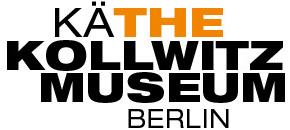
Many families live in the neighbourhood. They pass the museum and cross the park in the direction of the school and daycare centre. Some adults have not yet noticed that the Kollwitz Museum has moved into the theatre building at Charlottenburg Palace. Suddenly their children are talking about Mrs Kollwitz and her works as they pass by.
These children visit the museum regularly. Step by step, they approach this special place, the world of Käthe Kollwitz and her art.
Which letters make up her name? When was she born and what games did children play back then? Is it still possible to learn something new at the age of 53?
They absorb everything in small steps. This is possible because the daycare centre and school are within walking distance. They return again and again, wander through the exhibition, draw the plastic mother with two children and select their favourite pictures.


Preschooler Mia chooses Konrad Calls Death. All the children gather in front of the picture while Mia explains why she chose it: ‘The barefoot girl is Mrs Kollwitz, her brother is sitting on the bench. As she walks past, he calls out as she stands up: ‘Käthe, put your shoes on!’ She likes this story. A child interjects: ‘Or they’re about to go on a barefoot path and he wants to take his shoes off too.’ The group is divided – the interpretation remains open. We continue our tour to the next favourite picture.
The visits are realised in close cooperation between MuseumsOutreach and some exceptionally committed educators. They take their responsibility for education seriously and want to open their children’s eyes to culture, creative and independent thinking and personal responsibility far beyond what is generally expected. After all, their aim is to raise reflective, responsible and active citizens of democracy. This fits in well with the aims of the museum, which intends to make the art and values of the socially committed Käthe Kollwitz accessible to all age groups – including the youngest generation. The projects are process-orientated and experimental. Hours of work are invested in an informal, direct interaction with each other, testing what can be achieved when educators and museum educators work together as equals from conception to realisation. The result is a fusion of different expertise that benefits the children.
The preschool children at the ASB Kita am Schlosspark are now experienced museum and cultural travellers under the guidance of kindergarten teacher Johannes Hauenstein. Every Tuesday is their world exploration day, on which they travel all over Berlin. They explore, discover, draw, discuss and invent. Since summer 2024, Käthe Kollwitz has acted as a thematic starting point. After several visits to the Kollwitz-Museum, there were follow-up excursions, for example to Käthe Kollwitz’ great role model, Auguste Rodin and his Thinker in the Alte Nationalgalerie or to historical means of transport in the Technikmuseum.
The children at Schinkel Primary School have already completed several art projects under the guidance of educator and theatre teacher Maren Scheeder. During the sessions of open workshops at the museum, they not only developed their creative skills, but also practised formulating and pursuing ideas and organising themselves democratically. They were particularly interested in the feelings that the works of art evoked in them. Here, the expertise of museum education and theatre education complemented each other perfectly: through physical self-awareness and the re-enactment of certain postures and emotions, the children gained a new way of perceiving Kollwitz’ work.
For an example, they recreated the Tower of Mothers by Käthe Kollwitz and asked themselves: Who is protecting whom? How does it feel – warm, safe or perhaps trapped? Afterwards, they looked for images that matched their feelings and expressed them in drawings. This series of exercises resulted in a children’s flyer (in German) that can be used to independently explore the exhibition.

The opportunity to invite parents and present their own work and new skills is very important to the children. ‘Come and see what we’ve created!’ The invitations were sent out and the parents accepted them – some even several times.
In one family, the younger daughter attends the ASB Kita am Schlosspark. Together with her group, she sang ‘Kita a cappella’ at the foyer of the museum, among other things a song about Mrs Kollwitz.

„Da gibt es ein Museum Direkt ganz nah am Schloss Mit Bildern und Skulpturen im Erdgeschoss Geschaffen von Frau Kollwitz Wie schön die sind Und ich bin, ich bin ja ein Museumskind“
The older daughter of the family already attends the Schinkel School and has printed pictures in the museum. Together with her schoolmates from the all-day care programme, she is now putting on a short play that corresponds to her works.

Proud parents, shining children’s eyes. The younger sister of our former school intern is also there. New connections are formed and strengthened. People start a dialogue. The Kollwitz Museum begins to take root in the neighbourhood.

Imprint:
Co-operation partner:
ASB Kita am Schlosspark
Nursery teacher: Johannes Hauenstein
2024 Autumn / 8 dates + presentation
Open all-day area of the Pestalozzi-Fröbel-Haus at the Schinkel primary school
Educator: Maren Scheeder
2024 Autumn / 7 dates + presentation
Text: Barbara Antal / Project management and realisation





